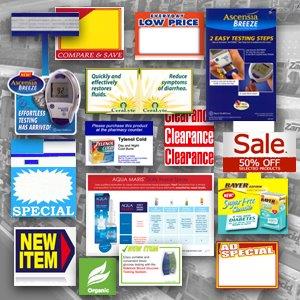by Jen Johnston, part 2 of the At Shelf: Signs blog series
This is the second post in my series on shelf signs. In my first post, I discussed the benefits of having shelf signs as part of your pull-through strategy, and I shared an amazing statistic: shelf signs can increase product sales a whopping 65%! Since there are so many different types of signs, I decided to put together a glossary to help you understand the different terms. In the coming weeks, I will dive into detail on each type of sign and outline when they are most appropriately used.
So starting with the phrase “shelf sign” itself, you might hear another term called “shelf talker.” Both of these phrases refer to signs in the general sense and not a particular style of sign.
And now here are the types of shelf signs:
- Wigglers are also known as danglers. They hang straight down from the shelf below your product.

- Wobblers are signs that arc up slightly and then down. They move freely when passersby create wind with their steps.
- Flat shelf signs sit parallel to the shelf. They are the least dynamic sign but they are cost effective and often are enough to get the job done.
- Aisle violators are positioned perpendicular to the shelf. They “violate” the space in the aisle and command attention. They are also known as aisle invaders, aisle breakers, shelf flags, and aisle interrupters.
- Folded shelf talkers are similar to flat shelf signs but they adhere to the top of the shelf and then fold over. They are also known as folding shelf signs or shelf stack cards.
- Channel strips are long, thin signs that get clicked or slid into the channel underneath your product. These types of signs work well for a brand with many facings.
- Aisle blades are mounted perpendicular to the shelf like aisle violators, but are much larger with their length typically spanning two or more shelves.
Now that you have a general overview of the different sign types, I hope you will feel more confident when speaking to retailers about what POS materials you can develop for their shelves.

